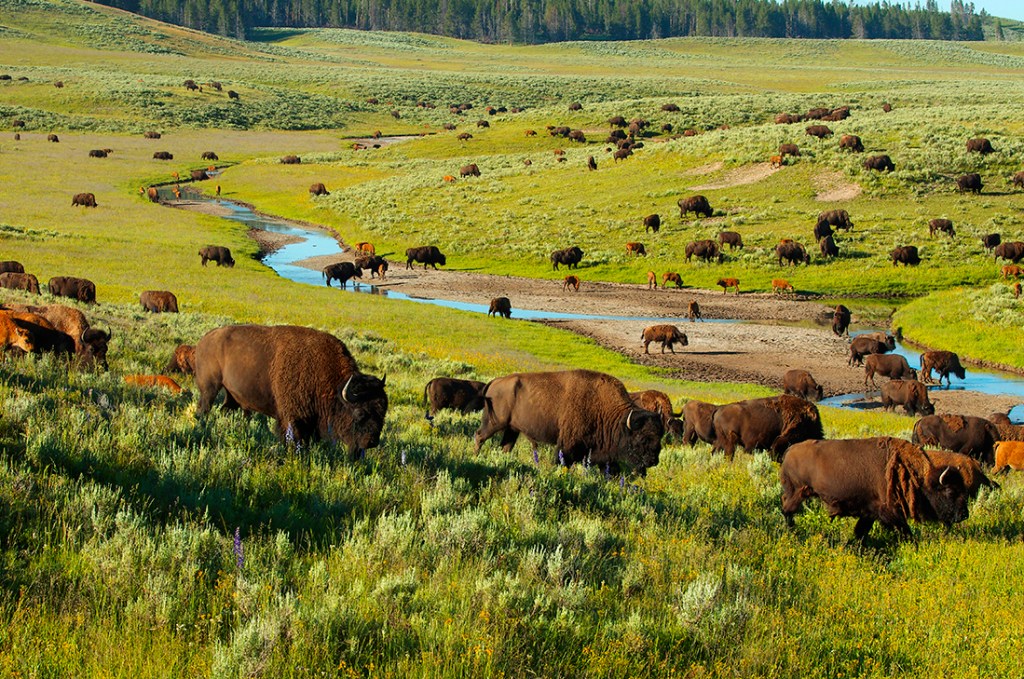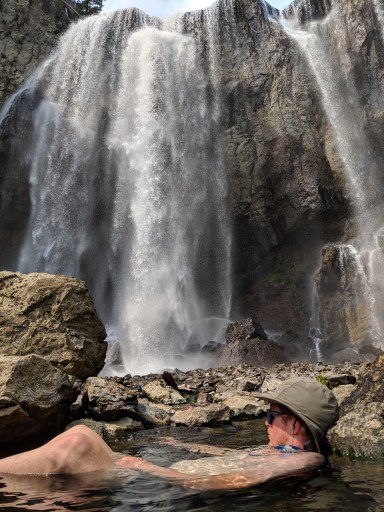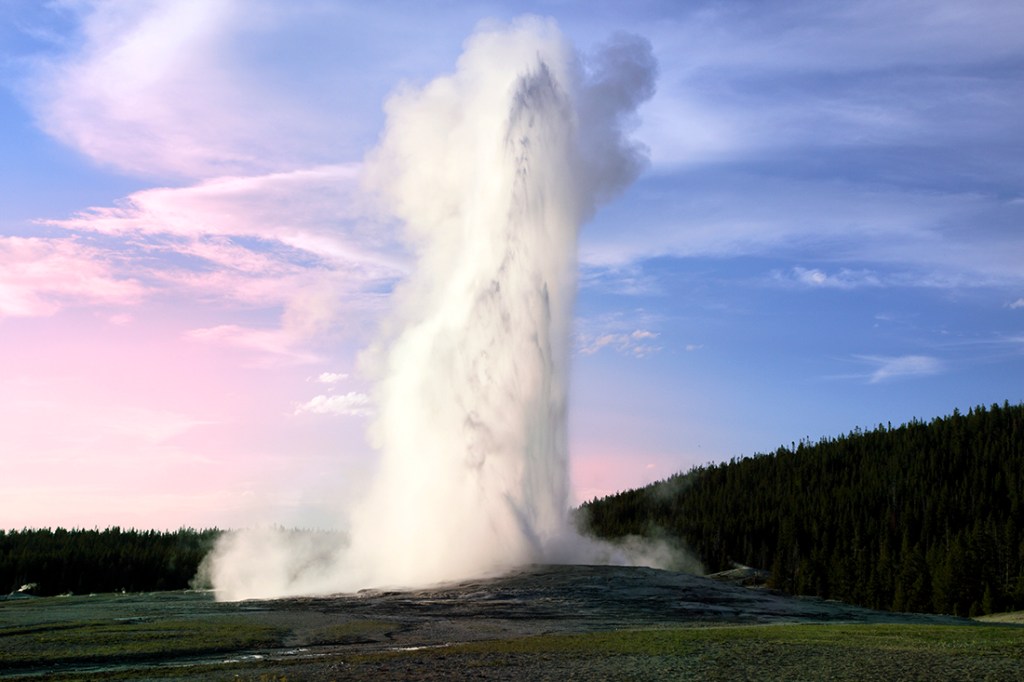Each year, millions of people visit Yellowstone National Park, and with good reason: It’s home to spectacular wildlife such as bison and elk; hundreds of miles of trails; gorgeous high-altitude lakes and famously, the world’s largest collection of geysers, including the ever-popular Old Faithful.
While many visitors opt to stay in lodges, travel by car and stroll only short distances to view the many magnificent sights, consider a more intimate and immersive experience by camping, hiking, backpacking, bicycling or boating. If you really want some spectacular solitude, visit in the wintertime, when you can cross-country ski or snowshoe and practically have the place to yourself.
Read on for our insider tips to take you out of your vehicle and into the wild.

A herd of bison roam in Yellowstone’s Hayden Valley.
Then, once you’re ready to take your trip, use our Yellowstone National Park Backpacking Gear List to help you prepare.
Camping in Yellowstone
There are 12 car-accessible campgrounds with more than 1,700 sites. Five of the campgrounds accept reservations, while the other seven are first-come, first-served. Following are three recommendations for campsites, keeping in mind a balance of convenience, location and size.
Slough Creek Campground (23 sites, non-reservable): This is one of the most popular campgrounds in the park and rightfully so. It is located between the Lamar Valley and Tower-Roosevelt areas with excellent wildlife viewing nearby as well as fishing in Slough Creek, and it has only 23 campsites so it never feels crowded. Scenic Beartooth Pass is just a short drive away.
The campsites usually fill up by 8 a.m., so get there early. Slough Creek typically opens in mid-June and closes in early October.
Canyon Campground (273 sites, reservable): Located in one of the most popular parts of the park, Canyon Campground sits at about 7,900 feet in elevation in the middle of a lodgepole pine forest. The campground is centrally located, making it easy to get around. There are several popular hikes nearby, including an easy stroll to Cascade Lake or a strenuous trek to Mt. Washburn.
The campground is open from the end of May to mid September. Reservations can be made online or by calling (307) 344-7311.
Pebble Creek Campground (27 sites; non-reservable): To get away from the crowds, try Pebble Creek Campground. Located near the Northeast Entrance to Yellowstone, Pebble Creek offers an excellent view of the Absaroka mountain range and is close to day hiking and backpacking options. The sites fill up quickly in the summer.
Hiking and Backpacking in Yellowstone
Yellowstone has more than 900 miles of hiking trails. You can link trails together to create a multiday backpacking trip, or head out for a day hike.
Backcountry camping is permitted in designated backcountry sites with a Backcountry Use Permit. You can make advance reservations for backcountry sites by submitting an application from January 1 to October 31 of each year. You must pick up your permit in person no more than 48 hours in advance of your trip.
For more information on planning your hike, visit the Yellowstone National Park day hiking page and the backcountry camping and hiking page. You can also use the National Park’s Day Hiking Guide and Backcountry Trip Planner to help find places to go.
The following are some suggestions for day hikes and backpacking routes, organized by general area of the park.
Bechler River Area
Explore remote rivers and streams, geysers, hot springs and flower-filled meadows in the southwest corner of the park.

A backpacker lounges in a hot spring below Dunanda Falls in Yellowstone National Park. (Photo Credit: Sam Morse)
Lone Star Geyser day hike (easy; 4.8 miles round-trip): If you want to escape the crowds that flock to Old Faithful, consider the easy 4.8-mile round-trip hike to Lone Star Geyser. The trailhead is just east of the Kepler Cascades trailhead. Lone Star erupts 30 – 45 ft. in the air about every three hours.
Dunanda Falls day hike or overnight (easy to moderate; 16 miles round-trip): Eight miles in from the Bechler Ranger Station on the Boundary Creek Trail, Dunanda Falls is a spectacular waterfall formed by Boundary Creek flowing over dark volcanic rock. It’s bordered by steep slopes grown over with thick grass and wildflowers. Enjoy watching the waterfall as you soak in the hot springs located just downstream from the falls.
Black Canyon Area
Quickly leave the crowds behind with a trip through Black Canyon on foot. Located near the northern border of Yellowstone, the Black Canyon area reveals a section of the Yellowstone River that pours over waterfalls.
Black Canyon backpack (moderate; 25 miles point-to-point): Enjoy a moderate 4-day backpacking trip starting at Hellroaring Creek Trailhead and continuing downriver on the shores of the Yellowstone River. You’ll have an excellent chance of seeing elk, bison, coyotes, moose, deer and the occasional bear.
Bring a fishing pole along to fish for trout in the famed Yellowstone River (a fishing permit is required). As you make your way out towards the Blacktail Trailhead you’ll pass through a beautiful valley of huge meadows and isolated stands of trees. Hiking 5-8 miles per day, you’ll have plenty of time to relax and recharge.
Gallatin Mountains
Tucked away in Yellowstone’s northwestern edge, the Gallatin Mountains are a hidden gem that go largely unexplored by park visitors. The area offers expansive views and stunning scenery. You can camp at lakes, explore creeks and scramble up 9,000 foot-tall peaks.
Gallatin Mountains backpack (moderate to advanced; 25-mile loop): Enjoy a moderate to advanced 4-day backpacking loop starting at the Specimen Creek Trailhead in the scenic Gallatin River Valley. You’ll exit along the north fork of Specimen Creek before rejoining the trail you started the trip on. Along the way you can camp on the shores of Specimen Creek, High Lake and Shelf Lake.
Be sure to scramble up Bighorn Peak from Shelf Lake to reach the best part of the Gallatin Crest. The route to the top of Bighorn Peak is exposed, but travel is easy. The summit offers stunning 360-degree views of the Gallatin Range, Madison Range and the Absaroka Range. Bighorn sheep frequently visit this area. Exit via the north fork of Specimen Creek.
Pebble Creek Area
In the northeastern corner of the park, a tributary of the Lamar River called Pebble Creek flows south through a beautiful glacial valley.
Pebble Creek/Bliss Pass day hike or backpack (easy to moderate; 12-mile round-trip or 19.5 miles point-to-point): Starting at the Pebble Creek Trailhead, hike upstream along the meadows adjacent to Pebble Creek as you enjoy spectacular views of the rocky peaks and eroding ridgelines on either side of the valley.
Day hikers may want to turn around about 6 miles upstream, but more intrepid hikers and backpackers can head west on Bliss Pass Trail and ascend 1,600 feet up a steep drainage with increasingly brilliant views. At about 9 miles from the trailhead you’ll reach Bliss Pass and enjoy views northeast into the Beartooths and west into the Slough Creek Valley.
To turn this into a 3-day backpacking trip, you can camp at the start of Bliss Pass Trail on the first night, then camp by Slough Creek on the second night. You’ll exit via Slough Creek, creating an enjoyable point-to-point backpack that’s about 19.5 miles long.
Hoodoo Basin Area
Located on the Absaroka Crest along the park’s eastern border, Hoodoo Basin contains a variety of bizarrely shaped volcanic “hoodoos” which look like giant drip sandcastles.
Hoodoo Basin backpack (moderate; 36 miles round-trip): Hoodoo Basin lies deep in Yellowstone’s backcountry in the Absaroka Mountains’ beautiful subalpine high country. You can reach the area by hiking 18 moderately difficult miles up the Lamar River and Miller Creek trails from the Soda Butte Trailhead. The Hoodoo Basin Trail takes off from there, letting you add on 5 or more miles.
While exploring the highly eroded hoodoo rock outcrops, also enjoy strolling through rolling subalpine meadows filled with wildflowers and majestic stands of Engelmann spruce and subalpine fir. Large herds of elk gather here to take advantage of the lush vegetation during the summer.
This trip can be done as a multiday out-and-back trip to Hoodoo Basin that covers 36 or more miles, or you can create a much larger loop that links up the Lamar River and Miller Creek trails with the Hoodoo Basin Trail, Sunlight Trail and Frost Lake Trail to bring you back around to the Lamar River Trail that you started on.
Canoeing and Kayaking in Yellowstone
Canoes, kayaks and other non-motorized boats are allowed on all lakes except Sylvan Lake, Eleanor Lake, Twin Lakes and Beach Springs Lagoon. Motorized boats are allowed on Yellowstone Lake and Lewis Lake. Permits are required for all boats, and if you plan to camp on the shore, you’ll need a backcountry permit. See the Yellowstone National Park Boating Regulations for more information.
Lewis and Shoshone Lakes: Shoshone Lake is the largest backcountry lake in the contiguous United States. Its shores have primitive campsites and there is no road access. To reach Shoshone, you’ll put your boat in at Lewis Lake and paddle up the Lewis River Channel. The channel gets shallow in places so you’ll spend some of the time walking in the water, pulling the boat along behind you. Side trips include a hike to Shoshone Geyser Basin to explore its many hot pools, steam vents, cauldrons and geysers. Lewis and Shoshone Lakes usually lose their ice by the second or third week in June.
You can launch your boat from a boat ramp located on the southeastern shore of Lewis Lake near the entrance to the campground. Motorized boats are also allowed to use this launch. Non-motorized boats only can launch from a roadside pullout along the northeast shore, but parking is very limited.
Yellowstone Lake: Yellowstone Lake is the second largest freshwater lake in the world above 7,000 ft. The 110 miles of shoreline provide access to amazing wilderness areas and many backcountry campsites. Paddle into Flat Mountain Arm to experience solitude in an amazing, high-altitude setting. Flat Mountain Arm is designated as a non-motor zone. Ice cover on Yellowstone Lake usually breaks up in late May or early June.
Boat launches for motorized and non-motorized boats are located at Bridge Bay Marina and Grant Village. Non-motorized boats that can be carried can launch from Sedge Bay along the northeastern shore. For day trips, you can also launch non-motorized boats from the parking area along Gull Point Drive.
Cross-Country Skiing and Snowshoeing in Yellowstone
There are miles of snowshoe trails and groomed and ungroomed cross-country ski trails in the park, and all unplowed roads are open to cross-country skiing and snowshoeing. Be aware that the North Entrance is the only entrance open to wheeled vehicles throughout winter. Also, the only way to access some areas of the park is via a motorized snowcoach or snowmobile. For more information, see the Yellowstone National Park Visiting Yellowstone in Winter page.
You can bring your own equipment or rent skis and snowshoes outside or inside the park. There are many options for ranger-led tours and guided trips with private companies.
Be prepared for cold weather and sudden storms. Read the Yellowstone National Park Cross-Country Skiing and Snowshoeing page for more information.
Old Faithful Geyser Basin: You can’t go wrong with the trails located in the Old Faithful area. There are easy groomed trails that leave right from the Old Faithful Lodge as well as a groomed trail that goes to the Lone Star Geyser. You can combine a network of ungroomed trails to explore Biscuit Basin, Daisy Geyser, Fern Cascades and Mallard Lake.

Old Faithful erupts in Yellowstone National Park.
Be sure to explore the easy trail to Fairy Falls. The 200-foot waterfall freezes in winter, creating a spectacular sight.
There’s a dedicated snowshoe trail that heads north from Old Faithful to Observation Point and Solitary Geyser.
Hayden Valley: For an outing that takes you deeper into the park, explore the Hayden Valley area along the Yellowstone River. The relatively flat terrain makes for great cross-country skiing and snowshoeing. There are stunning views of the surrounding hills, and herds of bison frequently gather in this area. You’ll likely need to hire a snowcoach or snowmobile to access this area.
For more ideas, see the Yellowstone National Park Ski and Snowshoe Trail Maps.
Biking in Yellowstone
All roads in Yellowstone National Park are open to cycling. Bikes are not allowed on backcountry trails or boardwalks.
Camping for bikers is limited to developed campgrounds in the park.
There are several gravel roads throughout the park that are open to both bicycle and vehicle traffic, including Old Gardiner Road and Blacktail Plateau Drive. Mountain bikes are recommended on these roads.
There are also several routes restricted to bicycle and foot travel only. For more information, visit the Yellowstone National Park Bicycling page.
East Entrance to Sylvan Pass: Enjoy the steady climb from the East Entrance of the park at 6,951 feet to Sylvan Pass at 8,524 feet over a span of roughly 6 miles. You’ll take in excellent mountain views along the way and enjoy a quick ride back down.
For an extra-special experience, go in November or late March or early April when the road is typically closed to vehicles and only open to bikes. Access to this area of the park during fall and spring is entirely dependent upon road and weather conditions, so be sure to check before you visit.
Lamar Valley to Cooke City, Mont.: Pedal through the beautiful and wide Lamar Valley, passing by the Lamar River, Soda Butte Creek and Pebble Creek, as you climb your way to Cooke City. Enjoy lunch in Cooke City before turning around and heading back to your car. Keep your eyes peeled for bison, bears and wolves along the way.
You can choose any number of starting points along highway 212 to create the length of trip you want. From Tower Junction to Cooke City is about 32 miles one-way with 1,900 feet of climbing. To shorten the trip, park at a pullout or trailhead closer to Cooke City.
Tips for Visiting Yellowstone
Getting to Yellowstone
Encompassing 3,471 square miles, Yellowstone sits in the northwest corner of Wyoming, extending into Montana and Idaho. See the Yellowstone Directions & Transportation page for information about traveling to the area.
Yellowstone Fees and Passes
Fees for entering the park depend on the type of pass you choose and your method of transportation. You can opt for a single-use Yellowstone pass, or if you plan to visit nearby Grand Teton National Park you can save money by buying a joint pass. Frequent visitors might consider an annual Yellowstone pass, or if you plan to travel the country, the America the Beautiful Interagency Annual Pass covers all national parks and federal fee areas.
Yellowstone Weather and Road Conditions
Yellowstone National Park is open year-round. Summer is the high season with abundant wildlife viewing, including large herds of bison during the July-August mating season. Spring and fall offer cooler temperatures, fewer crowds and still plenty of accessible hiking. During winter, you’ll have the snowy landscapes and steaming geysers pretty much to yourself.
Visit the Yellowstone National Park weather page for more information.
If you’re planning to visit during spring, fall or winter, be sure to check current road conditions and the operating hours as not all roads and entrance stations are open during these seasons.
Yellowstone Maps
National Geographic Trails Illustrated maps do an excellent job of showing campgrounds, trailheads, trail mileage, boat ramps, marinas, scenic overlooks and interpretive trails. Available maps include the Yellowstone National Park Trail Map, Southeast Yellowstone/Yellowstone Lake Trail Map, Southwest Yellowstone/Old Faithful Trail Map, and the Northwest Yellowstone/Mammoth Hot Springs Trail Map.
Shop REI’s selection of Yellowstone National Park guidebooks and maps.
Lodging in Yellowstone
There are nine lodges with more than 2,000 rooms. All nine lodges are available during the summer and two are open in the winter (Old Faithful Snow Lodge and Mammoth Hot Springs Hotel).
Food and Supplies in Yellowstone
There are numerous restaurants, cafeterias, and snack shops throughout the park, ranging from fine dining to semi-fast food. If you’re gearing up for hiking, backpacking or kayaking, you can purchase food and other supplies at several general stores and outdoor stores located around the park.
Yellowstone Bear Safety
Yellowstone has a large population of bears. Before you head out for a hike or other activity, check in with the nearest visitor center or backcountry office for information on recent bear activity. It’s also important to know what to do if you encounter a bear. Visit the Yellowstone National Park website for more information on bear safety.
